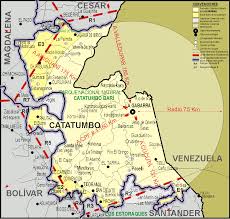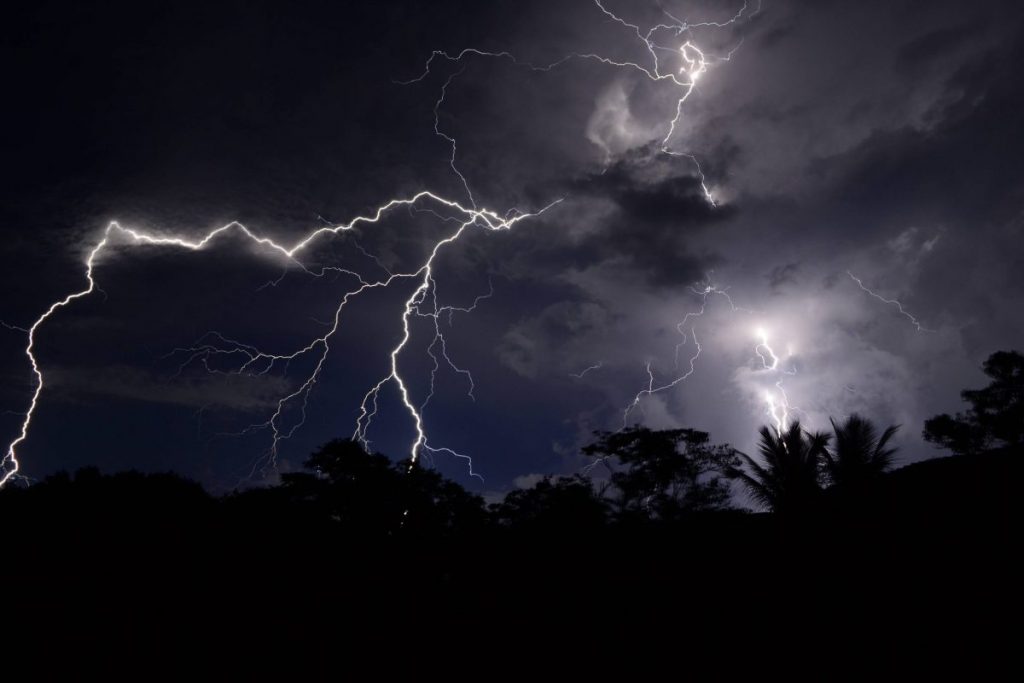
The territory limits to the north and west with the Republic of Venezuela, to the east with the southern area of the department of Cesar and to the south with the municipalities of Cúcuta, Puerto Santander, El Zulia and Villa del Rosario.
The Catatumbo River is a river in the north of South America, which rises in the area of Norte de Santander, in the eastern part of Colombia, specifically in the Jurisdicciones hill at 3,850 meters above sea level, in the municipality of Ábrego, west of the state, and flows into Venezuela in Lake Maracaibo, to which it contributes about 60% of its fresh water. Its mouth is in the form of a delta, which goes into the interior of the lake, breaking in a certain way its symmetry.
Its basin covers 24,416 km², of which 16,626 km² are Colombian territory and the rest of Venezuela.
Catatumbo Lightning (Spanish – Relámpago del Catatumbo) is an atmospheric phenomenon which occurs strictly in an area located over the mouth of the Catatumbo River where it empties into Lake Maracaibo.
Photo courtesy of Alan Highton. Catatumbo Lightning phenomena.
The frequent, powerful flashes of lightning over this relatively small area are considered to be the world’s largest single generator of tropospheric ozone, that is, ozone that does not replenish the stratospheric ozone layer. It originates from a mass of storm clouds that create a voltaic arc at more than 5 km of height, during 140 to 160 nights a year, 10 hours per day and up to 280 times per hour. It occurs over and around Lake Maracaibo, typically over the swampish area formed where the Catatumbo River flows into the lake.

Exploration of Catatumbo / Lake Maracaibo and the surrounding areas in western Venezuela – reveal a number of different ecosystems along the way. The wildlife in this region is abundant and colourful as are as the characters that live in the palafitos or stilted houses on the edge of the expansive Lake Maracaibo.
Few people are lucky enough to experience this natural phenomenon and enjoy the surroundings of the area’s different ecosystems with its plentiful wildlife.
Guided tours run year-round although the best time to view the lightning is May / June through November. Departures usually arranged from Mérida and coordinated with other tours in the area.
– The Catatumbo Lightning is currently part of the flag, coat of arms and anthem of the state of Zulia and is present in its various cultural expressions.
– Catatumbo was declared a Natural Heritage Site of Zulia by the Government of the state of Zulia on September 27, 2005.
– The first written mention of the Catatumbo lightning was in the epic poem “La Dragontea” (1597) by Lope de Vega, which recounts the defeat of English raider Sir Francis Drake.
– The Prussian naturalist and explorer Alexander von Humboldt once described it as “electrical explosions that are like phosphorescent ”
— Italian geographer Agustin Codazzi described it as a “lightning that seems to arise from the continued Zulia River and its surroundings.”
– This phenomenon has been popularly known for centuries as the Lighthouse of Maracaibo, since it is visible for miles around Lake Maracaibo.